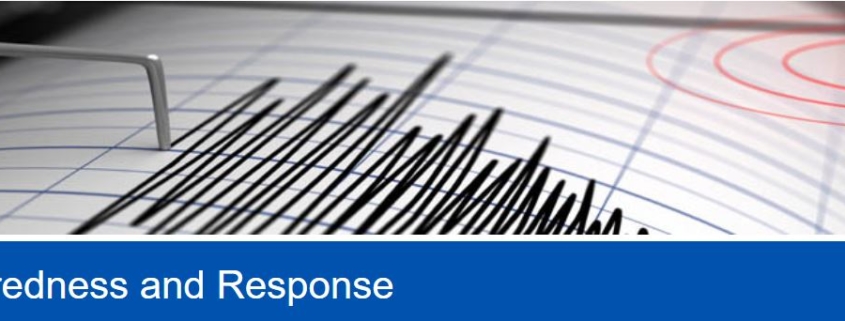Earthquake Preparedness at Work
Preparedness
The primary dangers to workers result from: being struck by structural components or furnishings, inadequately secured stored materials, burns resulting from building fires resulting from gas leaks or electrical shorts, or exposure to chemicals released from stored or process chemicals. Many of the hazards to workers both during and following an earthquake are predictable and may be reduced through hazard identification, planning, and mitigation.
There are many things you can do to prepare your workplace before an earthquake occurs:
- Pick “safe places”. A safe place could be under a sturdy table or desk or against an interior wall away from windows, bookcases or tall furniture that could fall on you. The shorter the distance to move to safety, the less likely that you will be injured. Injury statistics show that people moving as little as ten feet during an earthquake’s shaking are most likely to be injured.
- Practice drop, cover, and hold-on in each safe place. Drop under a sturdy desk or table and hold on to one leg of the table or desk. Protect your eyes by keeping your head down. Practice these actions so that they become an automatic response.
- Practice these safe earthquake procedures (i.e., drop, cover, and hold-on) at least twice a year. Frequent practice will help reinforce safe behavior. When an earthquake or other disaster occurs, many people hesitate, trying to remember what they are supposed to do. Responding quickly and automatically may help protect you from injury.
- Make a plan for workers to follow in the event of an earthquake and be sure that it includes the following precautions:
What are aftershocks?
Aftershocks are smaller earthquakes that follow the main shock and can cause further damage to weakened buildings. After-shocks can occur in the first hours, days, weeks, or even months after the quake. Be aware that some earthquakes are actually foreshocks, and a larger earthquake might occur.
- Wait in your safe place until the shaking stops, then check to see if you are hurt. You will be better able to help others if you take care of yourself first, and then check the people around you. Move carefully and watch out for things that have fallen or broken, creating hazards. Be ready for aftershocks.
- Be on the lookout for fires. Fire is the most common earthquake-related hazard, due to broken gas lines, damaged electrical lines or appliances, and previously contained fires or sparks being released.
- If you must leave a building after the shaking stops, use the stairs, not the elevator, and look for falling debris. Earthquakes can cause fire alarms and fire sprinklers to go off. You will not be able to rule out whether there is a real threat of fire, and the elevators may have been compromised. Always use the stairs.
- If you’re outside in an earthquake, stay outside. Move away from buildings, trees, streetlights and overhead lines. Crouch down and cover your head. Many injuries occur within ten feet of the entrance to buildings. Bricks, roofing and other materials can fall from buildings, injuring persons nearby. Trees, streetlights and overhead lines may also fall, causing damage or injury.
- Inform workers of the plan and discuss earthquakes with workers. Everyone in your workplace should know what to do if an earthquake occurs. Discussing earthquakes ahead of time helps reduce fear and anxiety and lets everyone know how to respond.
- Get training. Take a first-aid class from an organization such as the American Red Cross, American Heart Association, or National Safety Council chapter. Get training on how to use a fire extinguisher. Keep your training current. Training will help you to keep focused and know what to do when an earthquake occurs.
- Businesses can use the Federal Emergency Management Agency How to Series for protecting people/property during emergencies. Perform a workplace survey, especially if you are in an area with a high risk of earthquakes, to identify potential hazards to workers if an earthquake occurs. Look for furniture or materials that could fall and strike workers or block means of egress, or cause a release of hazardous materials, or otherwise affect the health and safety of workers as a result of utility loss or system/structural failure. Follow mitigation techniques recommended by FEMA for equipment and furniture.
Employers whose workers will be involved in emergency response operations for releases of, or substantial threats of releases of, hazardous substances regardless of the location of the hazard must comply with OSHA’s Hazardous Waste Operations and Emergency Response (HAZWOPER) standard, 29 CFR 1910.120. This may include emergency response following an earthquake. Instruction CPL 02-02-073 describes OSHA enforcement procedures under the relevant provisions of the HAZWOPER standard.
The U.S. Environmental Protection Agency (EPA) has promulgated a standard applying OSHA’s HAZWOPER standard to state and local government workers in states where there is no OSHA-approved State Plan. See 40 CFR Part 311.
OSHA’s HAZWOPER Safety and Health Topics page explains requirements of the OSHA HAZWOPER standard, including required worker training.
Equipping
Get emergency supply kits and keep them in shelter locations.
- Basic Disaster Supplies Kit. Ready.gov – Federal Emergency Management Agency (FEMA). Lists supplies needed for a disaster kit.
- Workplace Plans. Ready.gov – Federal Emergency Management Agency (FEMA). Provides basic information on developing an emergency management plan for the workplace.
- Emergency Supplies for Earthquake Preparedness. Centers for Disease Control and Prevention. (CDC). Lists supplies needed for an earthquake preparedness kit.
Training and Exercises
- Ensure that all workers know what to do in case of an earthquake.
- Practice earthquake and evacuation plans on a regular basis.
- Update plans and procedures based on lessons learned from exercises.
OSHA’s Disaster Site Worker Outreach Training Program is a training program for workers who provide skilled support services (e.g., utility, demolition, debris removal, or heavy equipment operation) or site clean-up services. The program highlights the differences between disaster sites and construction sites, and emphasizes the need for workers and employers to have pre-incident training.
ShakeOut is an annual global earthquake drill supported by FEMA, the U.S. Geological Society (USGS), the National Science Foundation, and others. Businesses and other organizations can register and participate for free. ShakeOut provides an earthquake Drill Manual for Businesses with lessons for workers and employers.
Develop an Emergency Action Plan
A disorganized evacuation can result in confusion, injury and property damage. An emergency action plan is critical. An emergency action plan checklist can assist this process.
When to evacuate: |
|
Evacuation plans should include: |
|











